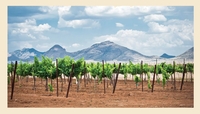There are a number of good reasons to visit Sedona, Arizona. The stunning and picturesque "red rock" country alone is a magnet for tourists. Proximity to Flagstaff and the Grand Canyon also rank high on the list. Then there is the perceived spiritual and healing aspect of a Sedona vortex; the Native American culture and history; and the hundreds of hiking trails.
 There is another attraction that doesn’t get as much attention, though awareness seems to be growing. The Verde Valley Wine Trail, which includes Sedona and the neighboring villages of Cottonwood, Clarkdale and Oak Creek, provides a glimpse into the potential of Arizona wine.
There is another attraction that doesn’t get as much attention, though awareness seems to be growing. The Verde Valley Wine Trail, which includes Sedona and the neighboring villages of Cottonwood, Clarkdale and Oak Creek, provides a glimpse into the potential of Arizona wine.
The Arizona wine industry may be minuscule by California, Oregon and Washington standards, but it is very real and, from all appearances, very promising. When most of us think of Arizona, the Phoenix area and intense heat come to mind, not verdant wine country.
The Verde Valley and the Cochise Valley (considered Arizona’s premier grape-growing region) to the south, near Tucson, are at elevation, high above the desert floor. Sedona sits at 4,500 feet above sea level, for example. The conditions and the soils, primarily limestone and sandstone, are compatible with viticulture. T his would be news to many wine enthusiasts because awareness of Arizona wine and its potential is but a recent development.
I stumbled across the Verde Valley Wine Trail by accident while taking a shortcut off Interstate 17 into Sedona. My curiosity was aroused while driving north through the rugged Page Springs area and passing four wineries and/or winery tasting rooms.
Upon reaching my vacation destination, I was pleased to find Arizona wines on a number of restaurant wine lists and pleasantly surprised to discover the wines were rock-solid. Sufficiently intrigued, I carved out some time to visit Cottonwood, about a 20-minute drive from Sedona. The winery tasting rooms — and there are six — are situated in Old Town Cottonwood and have a rustic western aura about them.
A few have restaurants, and I chose Merkin Vineyards Tasting Room and Osteria for lunch and a flight of white, rose and red wines made from Arizona grapes. Lunch was superb. So were the wines, with the exception of an orange wine that I suppose would work for someone who actually enjoys the oxidative characteristics of orange wine, which I don’t.
 What struck me most, besides the excellent quality, was the creativity of the blends offered. There was a Riesling (75%)-Chardonnay (25%) offering and a Malvasia Bianco (70%)-Albarino (30%) offering that were both quite refreshing and well balanced. The red blends included a Sangiovese (60%) and Negroamaro (40%) blend that you would be hard-pressed to find in Italy, where those two grapes are traditional.
What struck me most, besides the excellent quality, was the creativity of the blends offered. There was a Riesling (75%)-Chardonnay (25%) offering and a Malvasia Bianco (70%)-Albarino (30%) offering that were both quite refreshing and well balanced. The red blends included a Sangiovese (60%) and Negroamaro (40%) blend that you would be hard-pressed to find in Italy, where those two grapes are traditional.
My brief visit wasn’t intended to be a deep dive into Arizona wine. It was, however, enough to convince me Arizona wine has enormous potential and merits closer attention.
8
